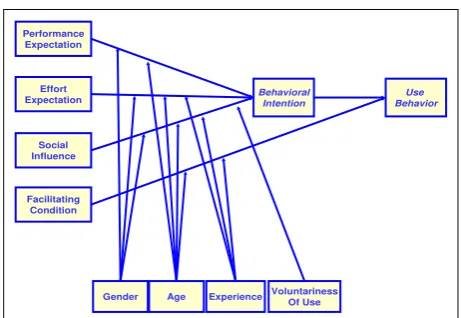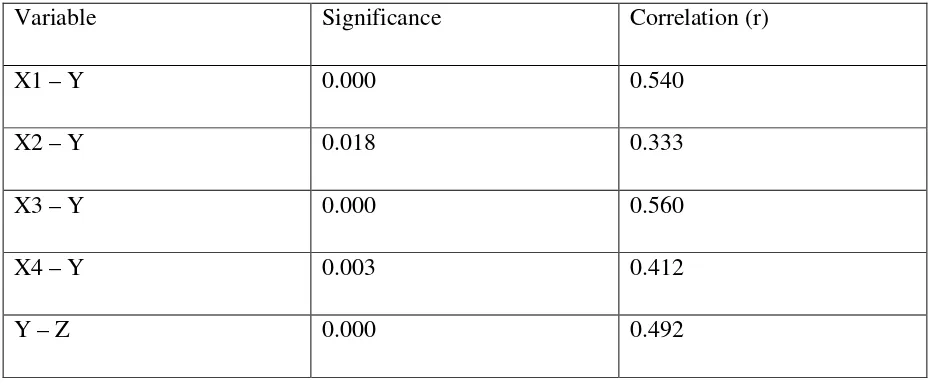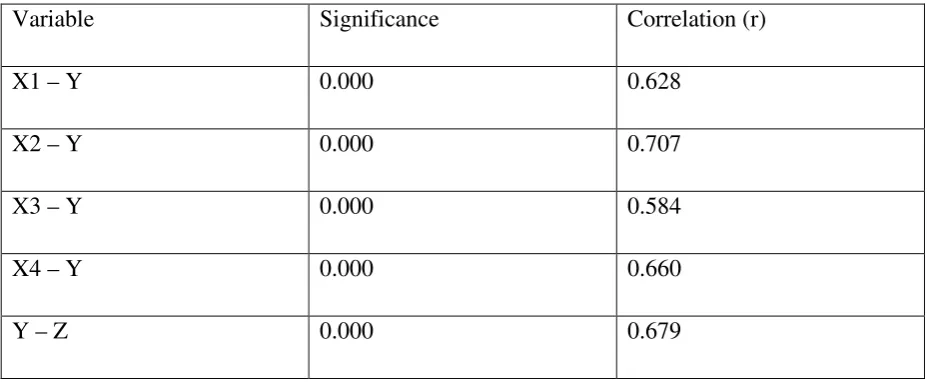1
Behavioral Analysis of Information Technology Acceptance in
Indonesia Small Entreprises
Small manufacturing enterprise (SMF), based on its unit numbers and the number of involved labors, has the potentials to play an important role in the Indonesia’s economy. However, its contribution to the national economy (i.e., GDP) has been minimal as to compare with its medium and large enterprise counterparts. This indicates that improvement of SMF’s productivity is required. Information technology, especially internet technology, application within SMFs is regarded to have significant impact on their business performance. The objective of this research are to examine some factors that influence intention of utilization and usage of Information technology to performance company, based on the model UTAUT (Unified Theory of Acceptance and Use of Technology) proposed by Venkatesh et al., (2003). 150 SMF operators—from which primary data were collected, and path analysis were used in this study. It was found that internet adoption was significantly affected by perceived usefulness, perceived ease of use, internet self efficacy, and internet anxiety. Firms’ business performance, however, was not significantly affected by internet adoption.
Keywords: Information and Communication Technology, behavioral model, Firm performance
JEL Codes : M15, D23, L25
∗Correspondence:
2 1. Introduction
As reported by the Ministry of Cooperatives and Small and Medium Enterprises
(CSME) in 2004 the number of small business was 43,158,468 units (99.85% of total
businesses) involving 70,919,385 workers (89.24% of total workers in industry sector).
However, its contributions to the nation’s Gross Domestic Product (GDP) and export values
has been minimal as to compare with its number of business units and workers involved.
Contributions of small, medium, and large enterprises to GDP were, respectively,
IDR820,491,528 millions (40.36%), IDR315,372,815 millions (15.51%), and
IDR896,960,557 millions (44.12%). Small enterpises’ contribution to export values was
IDR23,775,942 millions (4.05%) which is smaller than those of medium enterprises
(IDR67,904,169 millions or 11.57%) and large enterprises (IDR495,173,009 millions or
84.38 %).
The role of information technology in improving small businesses’ contribution to the
nation’s economy is of importance. However, the use of information technology in Indonesia
has generally been lower than those of most countries. Availability of information technology
infrastructure, number of unit of computers owned by enterprises, and internet access indicate
this. As reported by the World Bank (2002), Indonesia’s profile in information and
communication technology (ICT) application was as follows: computer ratio to population
was 9.9 per 1,000 residents; telephone connection was 91 per 1,000 residents; internet hosts
was 0.8 per 10,000 residents; and internet users was 2 millions. Invesment in ICT,
meanwhile, was USD3.54 billion (2.2% of GDP) which is equivalent to USD16.6 per capita.
A number of weaknesses of small businesses operators in Indonesia has been
3
(2002) include lack in (i) aggressiveness and capability in accessing market, and (ii) use of
information technology in developing small businesses. In relation to these weaknesses, is
relatively difficult. There are three main problems in encouraging small business operators to
use information technology. These include perception that information technology is
expensive and, therefore, it could not be afforded by small business operators; limited
technological resources and lack in information technology infrastructure; and both quantity
and quality of human resources.
The profound research on the information technology in the small-medium-scale is
important to analyze the aspects of information technology application in Indonesia,
particularly to identify how far the above problems become the determining factors in the
application of information technology and what are their implications towards the
performance of small-medium businesses in Indonesia. The success of information
technology application brings a wide range of dimensions which cover the parameters used to
measure the effectiveness of the information technology functions and also parties or groups
utilizing the applications of information technology. To the small-medium scale businesses,
the major party that dominantly concerns with the decision making is the owner and the
executives. They embrace important roles in the decision making which utilizing information
technology in their companies. Besides, their involvement in the process of technology
adoption holds important factors in improving the intensity of the use of information
technology.
4
A number of behavioral theories has been applied to examine the process of
information technology adoption by end-users. Some of which are Theory of Reason Action
(TRA), Theory of Planned Behaviour (TOB), Task-Technology Fit Theory (TTF), and
Technology Acceptance Model (TAM). Amongst these theories, Technology Acceptance
Model (TAM) was found as a model that has been widely used in various studies on adoption
process of information technology. Following these models, in 2003, Venkantesh and his
colleagues developed a new model called Unified Theory of Acceptance and Use of
Technology (UTAUT).
This model (i.e., UTAUT) was developed based on previous models on adoption of
information technology, which include TRA, TPB, TTF, and primarily Technology
Acceptance Model (TAM). TAM model, which was introduced by Fred D. Davis in 1986, is
an adapted model from TRA and is specifically developed for modeling information
technology adoption by users. According to Davis (1989), the primary objective of TAM is to
provide foundation for determining impacts of external factors on trust, attitude, and
objectives of information technology end-users. Relationships among variables within this
model are depicted in figure, which follows.
5
Figure 1. Technology Acceptance Model
In UTAUT theoretical model, according to Venkantesh et al. (2003), gender, age,
experience, and characteristics of IT application related to their position in the firm (i.e.,
optional or compulsory) serve as moderating effect on the use of certain information system.
Its predictor variables, meanwhile, includeperformance expectancy, effort expectancy, social
influence, and facilitating condition. The details of UTAUT model are presented in figure
below.
Behavioral Intention
Effort Expectation
Social Influence Performance
Expectation
Facilitating Condition
Use Behavior
Gender Age Experience VoluntarinessOf Use
Figure 2. UTAUT Model (Venkatesh et al., 2003)
Studies on the application of information technology within small and medium
enterprises have been limited as to compare with the application of this technology within
corporations or large enterprises. Small business operators or owners are individuals who
play important roles in directing the business’ policies and directions. Research results show
that there is a strong relation between small business owners’ perception toward information
6
(Heilman, Finnel, and Glorfeld, 1999). The impact of characteristics of information
technology users on adoption processes, menawhile, was investigated by Igbaria et al. (1997),
Gefen and Straub (1997), Foong (1999), Hubona and Jones (2003), Venkantesh et al. (2003),
and Kleijnen, Wetzels and Ruyter (2004). On theoretical model UTAUT (Unified Theory of
Acceptance and Use of Technology) which was reported by Venkatesh et al. (2003), gender,
age, experience, and chararteristics use relating to user position within the firms (compulsory
or optional), serve as moderating effect on use of information technology. Its predictor
variables are performance expectancy, effort expectancy, social influence, and facilitating
condition. Lee and Runge (2001) concluded that the company’s innovation possessed actual
influence toward the adoption of information system by SMEs; nonetheless in the case of
internet adoption, those variables had no influences. Lee stated (2004) that the adoption of
e-mail by SMEs owners or managers is influenced by their innovative ability.
According to Riemenschneider and Mykytyn (2000), characteristics of information
technology application within small business are as follows: (1) financial and accounting
activities are the major part of information technology application; (2) technological training
programs are directed primarily to its managers; (3) top management’s support and
involvement play an important role in achievement of the implementation of information
technology within the firms; and (4) in line with findings of most studies on information
technology, the involvement of end-users is the key aspect when they are satisfied. On the
other hand, OECD (2004), state that inhibiting factors for ICT application within small and
medium businesses include: (a) business process incompatibility; (b) limited managerial and
technical ICT application skills; (c) development and maintenance costs; (d) problems
7
and security in ICT application; (f) law uncertainty; and (g) various challenges relating to
electronic business process.
Riemenschneider and Mykytyn (2000) stated that key persons of small business as
end user of information technology tend to take into account computer self-efficacy, i.e.,
training and computer system application skills. Beside self-efficacy, Brown (2002), in his
research on web based technology adoption in developing countries includes computer
anxiety as an additional variable. His research results show that there is a strong effect of
computer anxiety on adoption of this type of technology. According to Wetzels and Ruyter
(2004), computer skills serve as moderating variable to PEOU. Mirchandani and Motwani
(2001) found that computer skills serve as predictor variable in e-commerce adoption by
small-scale businesses, with positive correlation coefficient. Bresnahan, Brynjolfsson, and
Hitt (2000), found that level of education and computer skills of end-user are weakly related
to computerized work and intensity of use of technology by end-user.
Level of ICT adoption variable,s which are used in those studies, are mostly
categorical, i.e. adopter and non adopter. In some publications, partial adopter and full
adopter are used for these terms. Van Akkeren and Cavaye (1999) classify small businesses
into 3 categories: non-adopter; adopter; and full-adopter. Referring to previous studies,
variables that will be analyzed in this study are as follows.
Table 1
Research Variables
No
. Predictor
Number
of item References
1. Performance
Expectancy
4 Gefen and Straub (2000); Venkantesh et al. (2003),
8
2. Effort
Expectancy
4 Gefen and Straub (2000); Venkantesh et al. (2003);
Gardner and Amoroso (2004)
3. Facilitating
Condition
4 Chau and Hu (2001); Venkantesh et al (2003); Anderson
and Schwager (2004); Klopping and McKinney (2004)
4. Social Influence 4 Maholtra and Galletta (1999); Venkantesh et al (2003)
5. Self Efficacy
5
(2001), Kleijnen, Wetzels and Ruyter (2004); Riemenschneider and Mykytyn (2000)
Response variable, on the other hand, is internet adoption level, which consists of 3
levels i.e., internet adopter, potential-adopter, and non-adopter. Based on the theoretical
review and previous research’s results, a set of hypotheses and research model for this
preliminary study are developed and depicted in the following figure.
Internet
Figure 1 Research Model
9
Subjects of the research are 150 SMF operators who are associated with the Indonesia’s
Association of Small Business Operators (HIPKI) in three sectors (manufacturing, trading
and services), which were randomly selected. Independent variables include (i) performance
expectancy, (ii) effort expectancy, (iii) social influence, (iv) facilitating condition. Two
dependent variables are behavioral intention and firm business performance.
Hypotheses to be tested are: (i) behavioral intention is affected by—either simultaneously or
partially—performance expectancy effort expectancy, social influence, facilitating condition,
and (ii) firm business performance is affected by behavioral intention.
4. Results and discussion
From this research is seen that value Alpha yielded is 0,9294, from the value can be said that
a measuring instrument wearied for the research of this is reliable and from corelation value
from the data can be said that an instrumen wearied for the good quality.
Result of the test correlation is to know the relation between two variables to be tested and as
used by free variable pervormance expectancy, effort expectancy, social influence and
facilitating condition. The independent variable will be tested by its relation to variable
behavioral intention and company performance.
The correlation between those variables can be seen in table as shown below
Table 2. Correlation between variables in services sector
Variable Significance Correlation (r)
X1 – Y 0.000 0.540
X2 – Y 0.018 0.333
X3 – Y 0.000 0.560
X4 – Y 0.003 0.412
10
Table 3. Correlation between variables in manufacturing sector
Variable Significance Correlation (r)
X1 – Y 0.000 0.525
X2 – Y 0.000 0.476
X3 – Y 0.000 0.487
X4 – Y 0.000 0.568
Y – Z 0.000 0.682
Table 4. Correlation between variables in Trading sector
Variable Significance Correlation (r)
X1 – Y 0.000 0.628
X2 – Y 0.000 0.707
X3 – Y 0.000 0.584
X4 – Y 0.000 0.660
Y – Z 0.000 0.679
The test result indicates that there are relations who are positive significant because from free
variable tested to be seen by a social inluence represent the variable having biggest influence
value to behavioral intention, later followed by performance expectancy, facitating condition
and effort expectancy. This matter told that the social environment the main factor which
11
Analysis of variance (ANOVA) for each submodel is shown in Tables 5. , internet technology
adoption is significantly (p<0.05) affected by the four mentioned independent variables.
Table 5. Analysis of variance model
Source of Sum of Squares df Mean Square F Sig.
Regression 3.654447243 4 0.913611811 2.889493 0.027142
Residual 26.24328003 83 0.316184097
Total 29.89772727 87
5. Conclusion
Variable predictor that are performance expectancy, effort expectancy, social influence and facilitating condition influence to the level of use information technology in SME , while variable effort expectancy and variable facilitating condition have the influence which enough reality. Social inluence variable has the biggest influence followed by variable of performance expectancy, facilitating condition and effort expectancy.
From research wich have been done, can be suggested as follows, with there are real influence from variable predictor to storey level use information technology and with the support of moderating variable is hence needed by a development and socialization from computer use specially in ICT.
References
[1] Anderson, John E. and Paul H. Schwager, SME Adoption Of Wireless Lan
Technology: Applying The Utaut Model, Proceedings of the 7th Annual Conference of the Southern Association for Information Systems, 2004.
[2] Barki, Henri and J. Hartwick. 1994., Measuring user participation, user involvement,
and user attitude. MIS Quarterly; 18, 1; p. 59.
[3] Bitler, Marianne P., Small businesses and computers: Adoption and performance1,
[email protected], 2001.
[4] Chambers, Todd A. and Craig M. Parker, Factors Motivating and Inhibitting the Use
of Web Commerce by Rural Small Bussiness, School of Management System, Deakin University, 2000.
[5] Chau, Patrick Y K and P. J. H. Hu. 2001. Information technology acceptance by
individual professionals: A model comparation approach. Decision Sciences; Fall 2001; 32, 4; pg. 699.
[6] Compeau, Deborah , C.A. Higgins and S. Huff. 1999. Social cognitive theory and
individual reactions to computing technology: A Longitudinal Study. MIS Quarterly; Jun 1999; 23, 2; ABI/INFORM Global, pg. 145.
[7] Fichman, Robert G. 2004. Going Beyond the Dominant Paradigm for Information
12
[8] Foong, Soon Yau, Effect of End User Personal and System Attributes on Computer
Based Information System Success in Malaysian SMEs. Journal of Small Business Management; 37, 3, hal 81, 1999.
[9] Gardner, Christina and D.L. Amoroso. 2004. Development of an Instrument to
Measure the Acceptance of Internet Technology by Consumers. Proceedings of the
37th Hawaii International Conference on System Science.
[10] Gefen, David and Detmar Straub, The Relative Importance of Perceived Ease of Use
in IS Adoption: A Study of E-Commerce Adoption, Journal of The Association for Information System: Volume 1, Article 8, Oktober 2000.
[11] Gera Surendra and W. Gu. 2004. The Effect Of Organizational Innovation And
Information Technology On Firm Performance. International Productivity Monitor, No. 9. Fall 2004.
[12] Kleijnen, Mirella, M. Wetzels, K.D. Ruyter. 2004. Consumer acceptance of wireless
finance. Journal of Financial Services Marketing; 8, 3; ABI/INFORM Global, pg. 206.
[13] Klopping, Inge M. and E. McKinney. 2004. Extending The Technology Acceptance
Model and The Task-Technology Fit Model to Consumer E-Commerce. Information Technology, Learning, and Performance Journal, Spring, 22; 1, pg. 35.
[14] Kohli, Rajiv and S. Devaraj, Measuring Information Technology Payoff: A
Meta-Analysis of Structural Variables in Firm-Level Empirical Research, Information Systems Research, 14, 2, ABI/INFORM Global, pg.127, Jun 2003
[15] Kraemer, Kenneth L., J. Gibbs and J. Dedrick. 2002. Impacts of Globalization on
E-Commerce Adoption and Firm Performance: A Cross-Country Investigation. Center for Research on Information Technology and Organizations, University of California.
[16] Kula, Veysel and Ekrem Tatoglu, An exploratory study of Internet adoption by SMEs
in an emerging market economy, European Business Review;; 15, 5; ABI/INFORM
Global, pg. 324, 2003.
[17] Lee, Younghwa, K.A. Kozar, and K. R.T. Larsen. 2003. The Technology Acceptance
Model: Past, Present, and Future. Communication of The Association for Information System, 12, 50, hal 752-780.
[18] Lee, Jungwoo, Discriminant Analysis Of Technology Adoption Behavior: A Case Of
Internet Technology In Small Business, The Journal of Computer Information Systems; 44, 4; pg. 57, 2004.
[19] Lee, Jungwoo and Janet Runge, Adoption of information technology in small
business: Testing drivers of Adoption for entrepreneurs, The Journal of Computer Information Systems; 42, 1; pg. 44, 2001.
[20] Riemenschneider and Mykytyn, 2002, “What Small Business Executives Have
Learned about Managing Information Technology”, Information & Management 37, page 257-269
[21] Riquelme, Hernan, Commercial Internet adoption in China: Comparing the
experience of small, medium and Large Business, Internet Research; 12, 3;
ABI/INFORM Global, pg. 276, 2002.
[22] Rosen, Peter A. 2004. The Effect Of Personal Innovativeness In The Domain Of
Information Technology On The Acceptance And Use Of Technology: A Working Paper. Oklahoma State University.
[23] Straub, Detmar; Marie-Claude Boudreau, and David Gefen. “Validation Guidelines
13
[24] Van Akkeren, Jeanette and Angèle L.M. Cavaye, Factors Affecting Entry-Level
Internet Technology Adoption by Small Business In Australia: An Empirical Study, Proc. 10th Australasian Conference on Information Systems, 1999.
[25] Venkatesh, Viswanath, Michael G. Morris, Gordon B. Davis, Fred D. Davis, User





